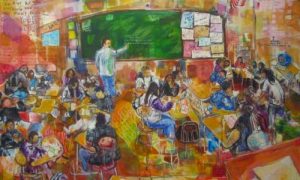PDF #158 – The Evolution of Model-Theoretic Frameworks in Linguistics
Model-Theoretic Frameworks in Linguistics – The varieties of mathematical basis for formalizing linguistic theories are more diverse than is commonly realized.

For example, the later work of Zellig Harris might well suggest a formalization in terms of CATEGORY THEORY, since Harris takes the utterances of a language to constitute a collection (possibly not even enumerable) that is not itself of particular interest, and concentrates on discussing a set of associative, composable mappings defined on it.
And thoroughgoing versions of generative semantics like Pieter Seuren’s seem to call for a formalization in terms of TRANSDUCERS, mapping meanings to phonetic forms and conversely.
However, work in formal syntax over the past fifty years has been entirely dominated by just one kind of mathematics: the string-manipulating combinatorial systems categorized as generative-enumerative syntax (henceforth GES) in Pullum and Scholz (2001).
A GES grammar is a recursive definition of a specific set, ipso facto computably enumerable.2 The definition is given in one of two ways: top-down or bottom-up. The classic top-down style of GES grammar is a program for
a nondeterministic process of construction by successive expansion symbol strings.
It amounts in effect to a program with the property that if it were left running for ever, choosing randomly but always differently among the possibilities allowed for expanding symbols, every possible string in the desired set would ultimately get constructed. Such a device is described as GENERATING the entire set of all structures the machine is capable of constructing.
After reading “Model-Theoretic Frameworks in Linguistics” you can check important issues for ESL teachers on the section PDFs, and visit my YouTube channel.
